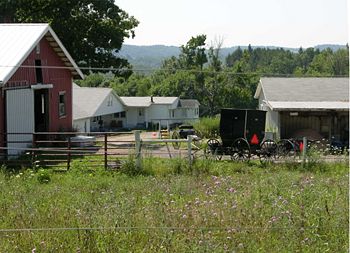Amish
The Amish are a Christian people whose movement is descended directly from the Anabaptists of the Protestant Reformation of the early 16th century. In the early years of the 1700s, many of them emigrated from their homeland in Europe to take up farming in colonial Pennsylvania, in the present-day territory of the United States. From there, they spread to other areas of the U.S. and Canada and today number about 200,000 adherents, most of whom are concentrated in the states of Ohio, Pennsylvania, and Indiana.
The Amish are divided into several major sub-groups all of which share the same basic precepts of simple living and adherence to the fundamental principles contained in the Schleitheim Articles, an early Anabaptist document which sets forth the concept of a "Christian brotherhood living in a viable community" (Hostetler, Amish Society, page 28). They are also united by their common ancestry, language, and culture. The major Amish groupings differ from one another in the details of how they implement their ideas concerning simple living, that is, how they live their lives and define their relationship to the rest of the world and to modern society, in particular, their relationship to modern technology.
It is this latter aspect of Amish life which has, more than anything else, fired the interest of the larger society around them. For, in stark contrast to that larger society, the Amish have steadfastly resisted the encroachments of modern conveniences and technology, eschewing even the most ubiquitous aspects of modern civilization, such as the automobile, electric appliances, and the computer. Instead, the Amish have retained many of the key elements of the past, including horse drawn vehicular transportation, horse-powered farming, and what seems to the society around them, an oddly anachronistic form of dress.[1]
By standing as an almost singular exception to the reducing forces of the American "melting pot", the Amish have inspired reactions ranging from distrust and hostility to an idealized, Romantic notion of pastoral simplicity. In this latter connection, the Amish have become the centerpiece of a burgeoning tourist industry in those areas where they can be found, an industry which feeds upon and nourishes the Romantic image while at the same time it may subtley be undermining the very lifestyle they idealize.
The pressures towards conformity and modernity on the Amish emanating from the larger society around them will continue to exert themselves raising the question as to whether the Amish will be able to survive in the long run or whether they will eventually succumb to those pressures or be fundamentally changed by the process of dealing with them.
Origins and history
The Amish trace their origins back to the Anabaptist movement of the early 16th century which, in its turn, grew out of the Protestant Reformation. Throughout the 15th century, economic and social pressures which threatened the existing social order had been mounting. Adding to the pressures, dissatisfaction with the Roman Catholic Church and calls for widespread reform had surfaced in many forms and were given voice by a number of critics, including John Hus, John Wycliffe, and others. These forces came to a head, especially in regards to the Church, when Martin Luther, in 1517, posted his famous 95 theses on the church door at Wittemberg, calling for broad reforms in the Church.
The Swiss Brethren and the Schleitheim Articles
The Amish division
The Amish emigration to America
Notes
- ↑ It should be noted that the various major groupings of the Amish are by no means homogeneous whether in their rules regarding acceptable technologies or other matters. Nevertheless, the rejection of the automobile and the computer, and the use of horse power, as well as their distinctive dress, are widely characteristic of most Amish groups and are certainly one of the outstanding characteristics of the Amish as a whole in the popular imagination. The differences among the various Amish groups in re technology and other matters is discussed in more detail further on in the article.
